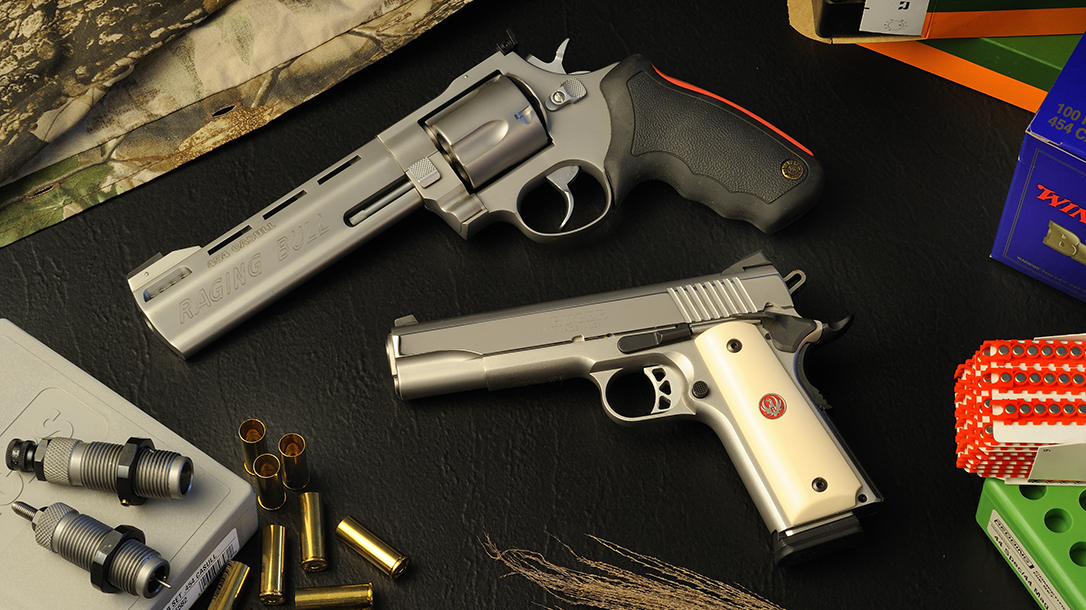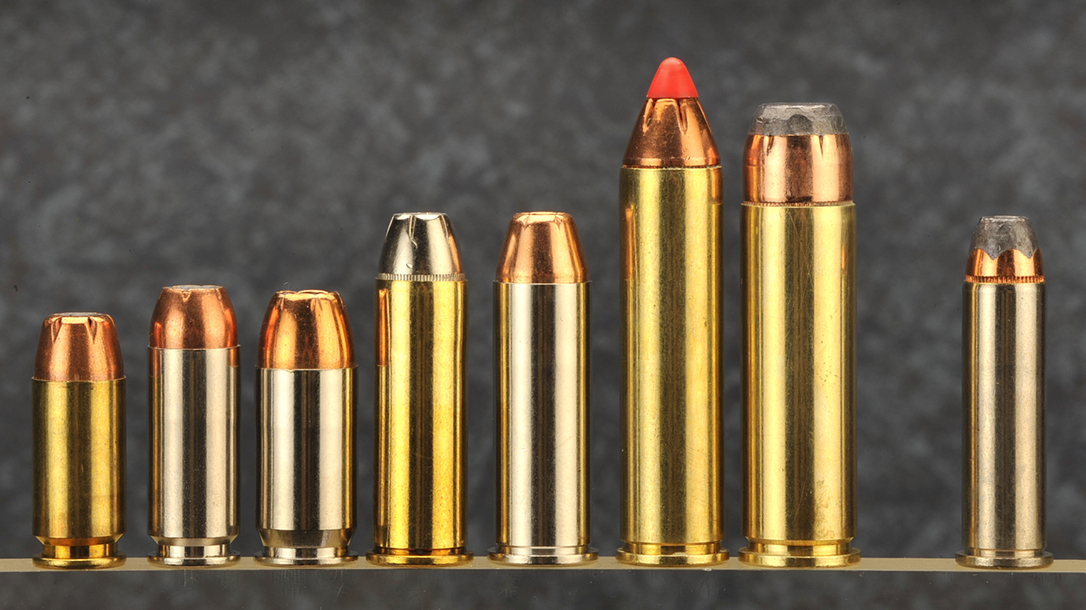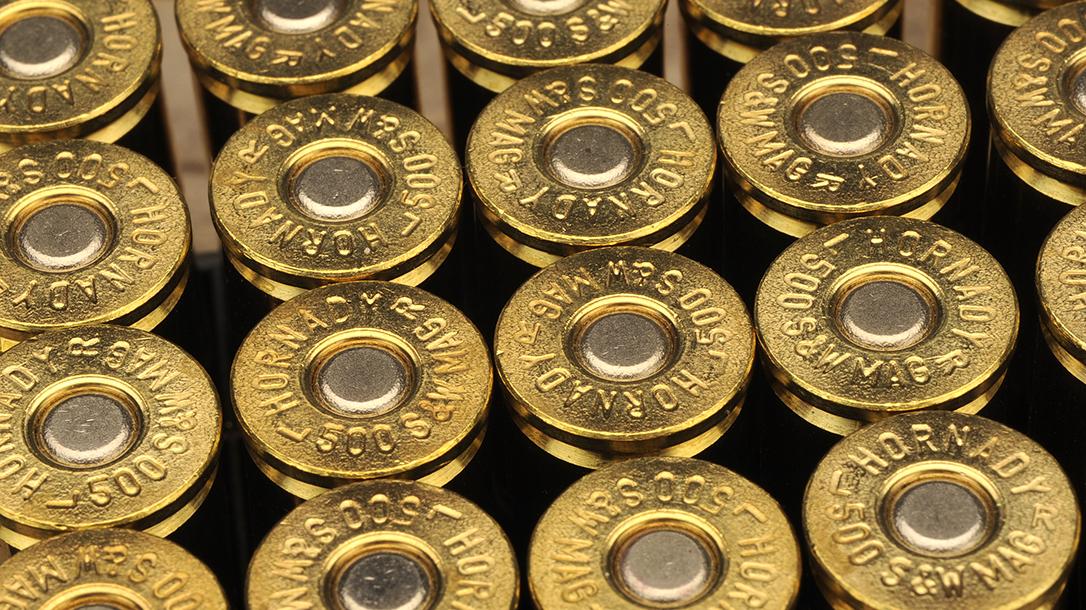We all love power. From pressing the gas pedal on a car for that extra burst of speed to cranking up the watts on a fine stereo, the adrenaline rush is there in an instant. When it comes to shooting, anything larger than .40 caliber will give you a feeling of excitement, whether it’s shot in a semi-automatic pistol or big-bore revolver.
Today, with the advent of technology, your preference in weaponry doesn’t seem to matter. For years, many hunters shied away from semi-automatic pistols because they weren’t as accurate and were prone to malfunctions if fed the wrong ammunition. Calibers were a consideration, of course, with most guns chambered for short, smaller cartridges such as the 9mm, .38 Super or .45 ACP.
Advertisement — Continue Reading Below
Today, tolerances have been tightened, and guns like the Desert Eagle, LAR Grizzly and AutoMag V, which go up and into the .50 AE range, get the job done with accuracy and power. But, although the AutoMag was perhaps a great gun when introduced in 1971, it depended readily on .44-caliber handloads crafted from .308 brass, so, unfortunately, it wasn’t accepted by most in the handgunning fraternity.
Revolvers seem to have rallied to the cause for handgun hunting. Looking up from our .40-caliber line in the sand, I’ve hunted with the .41 and .44 Magnums, and although they are a challenge on smaller varmints at longer distances, they can be very effective. They are comfortable to shoot, and you can easily mount scopes on them, too. Although the .41 has taken the backseat to new cartridges, it’s still chambered by Ruger in the Blackhawk series. For most of us, the .44 Magnum is the king of handgun hunting, but with the advent of the .454 Casull, .460 S&W Magnum, .480 Ruger, .475 Linebaugh and .500 S&W Magnum, it seems there’s nothing in the way of big game these big-bore cartridges can’t handle.
Why Use Magnum Handloads?
After choosing your weapon, you must decide whether to use factory rounds or handloads for hunting. If you’re the type of hunter who uses a rifle more than a handgun, factory fodder might be best. Conversely, if you like handgun hunting and spend more time with this challenging sport, handloading is the only way to go. Tailoring your shooting with magnum handloads allows you the freedom, for example, to use .44 Special-type loads for small game and heavier .44 Magnum loads for larger or more dangerous game.
Advertisement — Continue Reading Below
Cost is another factor, especially when shooting rounds like the .500 S&W Magnum, for example. These cases and bullets cost more, but the main ingredient — powder — takes up the lion’s share of the cost. A .44 Magnum round using a 240-grain bullet takes 24.5 grains of Winchester 296 to reach a maximum of 1,400 fps. With the .500 S&W Magnum and a 300-grain bullet, you must double that amount — 49.8 grains of the same powder — to reach this round’s full 2,000-fps potential. That’s a lot of extra propellant to yield a velocity only 43-percent greater than the .44 Magnum’s.
What You’ll Need for Magnum Handloads
Except for size, I’ve had no difficulty handloading the larger automatic or magnum cases for use in the field, and the usual practices apply. Starting with a good press, make sure you buy for quality, not price. Over the years, the press will sustain a lot of stress, especially when doing full-length sizing or heavy-duty crimping on larger cases. The same applies to a die set. A top-quality die set from Lyman, Hornady, RCBS or Redding will last for years. A few of the original die sets I purchased some 50 years ago are still going strong. Finally, because we’re mostly dealing with straight-walled cases, you should get a tungsten insert.
If you’re loading magnum handloads for a new gun, fresh cases are the order of the day. Purchase them in lots of 250 or more. They last a long time during normal loading conditions. Check the end flap of each box or container for the same lot number. I would stay away from bargain, second-hand or used cases, as you’re dealing with high-performance, high-pressure magnum calibers.
Advertisement — Continue Reading Below
Primers are next, and for the most part, you will be dealing with slow-burning powders, so I’d opt for the magnum-type of primer for complete ignition, which then leads to better accuracy. When setting the primer in the case, make sure it’s level with the rim or bottom of the case. Never mix primers, and for safety around the loading bench, keep them in the original packaging for later reference.
Today, handloaders are blessed with a multitude of powders to suit every hunting need. Working with our big bores, both classics and newer products come to mind. For the most in velocity, new powders such as Hodgdon Lil’Gun and Alliant’s Power Pro 300-MP or Power Pistol will do the trick, but Accurate No. 9, Alliant 2400, IMR 4227, Winchester 296 and Hodgdon H110 are all worth trying. For smaller .40-caliber rounds in autopistols, consider Hodgdon’s Longshot, CFE Pistol or HS6; Alliant’s Blue Dot, Bullseye, Power Pistol or Unique; or Accurate No. 5. Just starting out? Grab a pound of Unique, H110 or Alliant 2400 and have at it.
Bullets demand a tome to themselves. Looking through the various loading manuals, there are dozens of designs, all made for a specific job. The best thing is to read various resources and combine their information with the type of game you intend to hunt. Then pick out one and load it to various power levels, checking for the best accuracy at the terminal end.
Advertisement — Continue Reading Below
Reloading Time
With that settled, it’s time to reload. The first task is to run your new cases through the tungsten sizing die to bring them to a unified level for loading and rid them of oblong case mouths, for example. After that, check each for its overall length against the manufacturer’s specifications. Trim if necessary, then chamfer the inside and outside for the next step.
Belling (or expanding) the case mouth adds a bit of a flare so the bullet can enter the case without destroying the top portion. The best way to check this is to insert the bullet, and if it does not sit on the case, move the handle down more to allow the expanding die to enter the case a little. With larger cases, you should only allow a small bit of the bullet base to enter the case, as you don’t want to destroy the friction-fit between the bullet and case as you push them together.
Advertisement — Continue Reading Below
Priming is next. All you need to do is make sure the primer is fully seated in the primer pocket. For a bit of weatherproofing, a drop of a quality thin, clear lacquer around the periphery of the primer is good insurance on an expensive hunt. Later on, you can do this to the bullet/case juncture after the bullet is seated, again for weatherproofing.
Pick your powder, check the loading manual for the charge weight and check each on the scale. Never — and I mean never — take anything for granted when it comes to charging the case. Fine-grain propellants will let you drop a uniform charge into each case when the weight has been checked. However, it’s my policy to check every 10th charge to make sure nothing has moved. As a reminder, never try to identify any powder by its appearance. Fast-burning powders will, for example, destroy any gun with a double charge; if you’re not sure, get rid of it.
Bullet seating is easy, and I have my way of doing it for foolproof results. After priming and charging, I seat each bullet to the cannelure and place it back into the loading tray. When all is done, I move one cartridge to the press, remove the seating stem and turn the die down until I feel slight resistance. This will indicate the crimping part of the die is meeting the assembled case. Then I continue to turn the die down in very small increments until I’m happy with the crimp. The best way to check this is to hold the finished case up against a light. At this point, you should see a perfect rounded, inward curve where the case meets the cannelure.
Advertisement — Continue Reading Below
Finish by recording the load on or in the cartridge box. Then, if you have a chronograph, take everything out to the range and observe your hard-earned results at various hunting distances. Keep track of the groups, record everything and get ready for your hunt. You can thank me later.
This article is from the September/October 2018 issue of Combat Handguns Magazine. Grab your copy at OutdoorGroupStore.com.

























